instrument cluster SSANGYONG NEW ACTYON SPORTS 2013 User Guide
[x] Cancel search | Manufacturer: SSANGYONG, Model Year: 2013, Model line: NEW ACTYON SPORTS, Model: SSANGYONG NEW ACTYON SPORTS 2013Pages: 751, PDF Size: 72.63 MB
Page 390 of 751
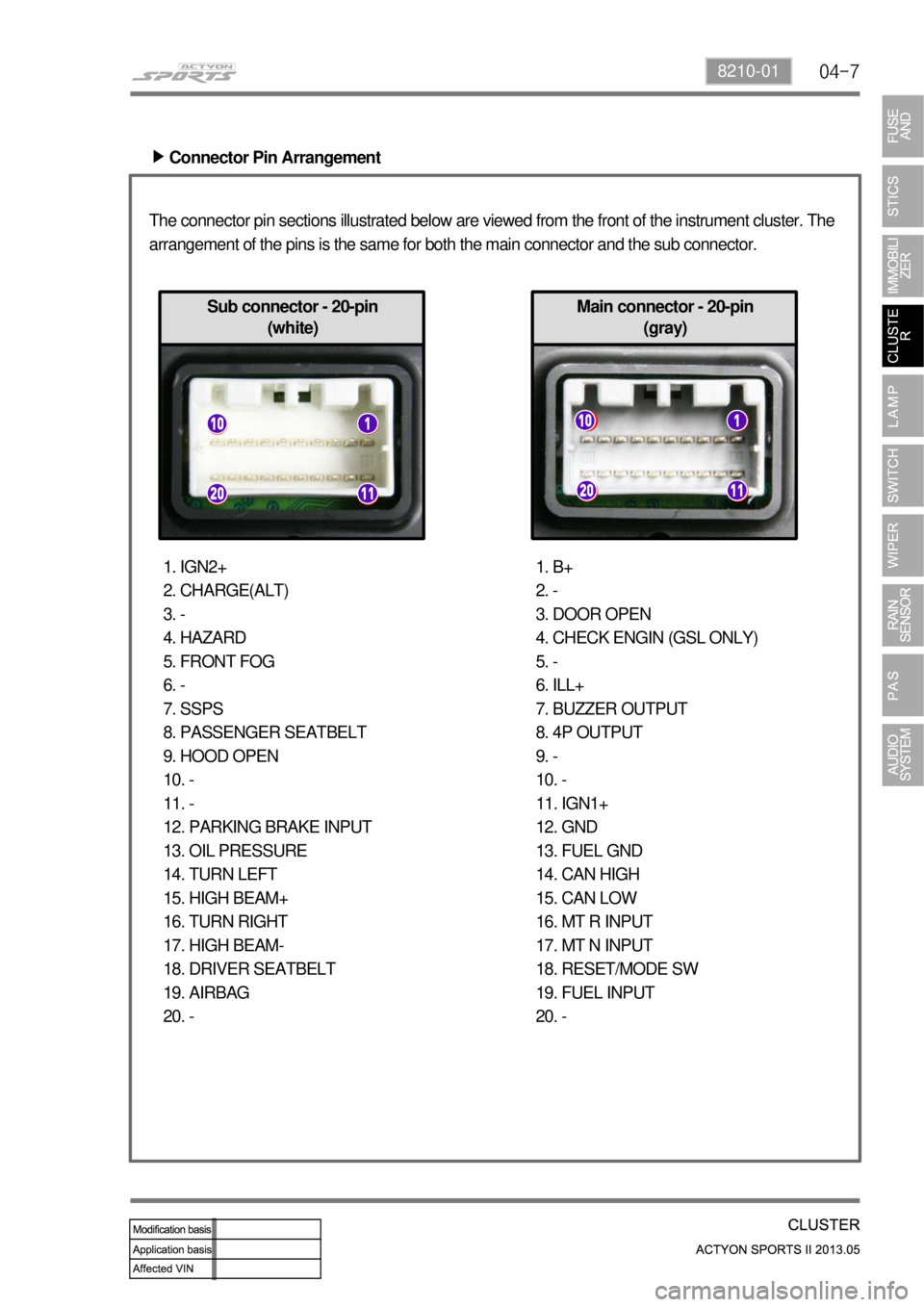
04-78210-01
Sub connector - 20-pin
(white)
Connector Pin Arrangement ▶
The connector pin sections illustrated below are viewed from the front of the instrument cluster. The
arrangement of the pins is the same for both the main connector and the sub connector.
1. IGN2+
2. CHARGE(ALT)
3. -
4. HAZARD
5. FRONT FOG
6. -
7. SSPS
8. PASSENGER SEATBELT
9. HOOD OPEN
10. -
11. -
12. PARKING BRAKE INPUT
13. OIL PRESSURE
14. TURN LEFT
15. HIGH BEAM+
16. TURN RIGHT
17. HIGH BEAM-
18. DRIVER SEATBELT
19. AIRBAG
20. -1. B+
2. -
3. DOOR OPEN
4. CHECK ENGIN (GSL ONLY)
5. -
6. ILL+
7. BUZZER OUTPUT
8. 4P OUTPUT
9. -
10. -
11. IGN1+
12. GND
13. FUEL GND
14. CAN HIGH
15. CAN LOW
16. MT R INPUT
17. MT N INPUT
18. RESET/MODE SW
19. FUEL INPUT
20. -
Main connector - 20-pin
(gray)
Page 391 of 751

04-8
Indicators on Instrument Cluster ▶
No. Symbol Item
1
Turn signal lamp-L
2
Turn signal lamp-R
3
4WD HIGH indicator
4Winter mode indicator
5Front fog lamp
indicator
6Cruise control
indicator
7Light illumination
indicator
8
High beam indicator
9
ABS warning lamp
10
Glow indicator
11
Immobilizer indicator
12Low fuel level warnig
lightPower Turning ON condition
Multifunction
switchWhen activating switch
Multifunction
switchWhen activating switch
IGN IGN ON/ CAN signal input
IGN IGN ON/ CAN signal input
Fog lamp
relayWhen activating switch
IGN IGN ON/ CAN signal input
BATT Tail lamp ON
Headlamp
high beam
relayWhen activating switch
IGNIGN ON/ CAN signal input
(ABS, EBD)
IGN IGN ON/ CAN signal input
IGN IGN ON/ CAN signal input
IGN When analog inputting fuel level
Page 405 of 751
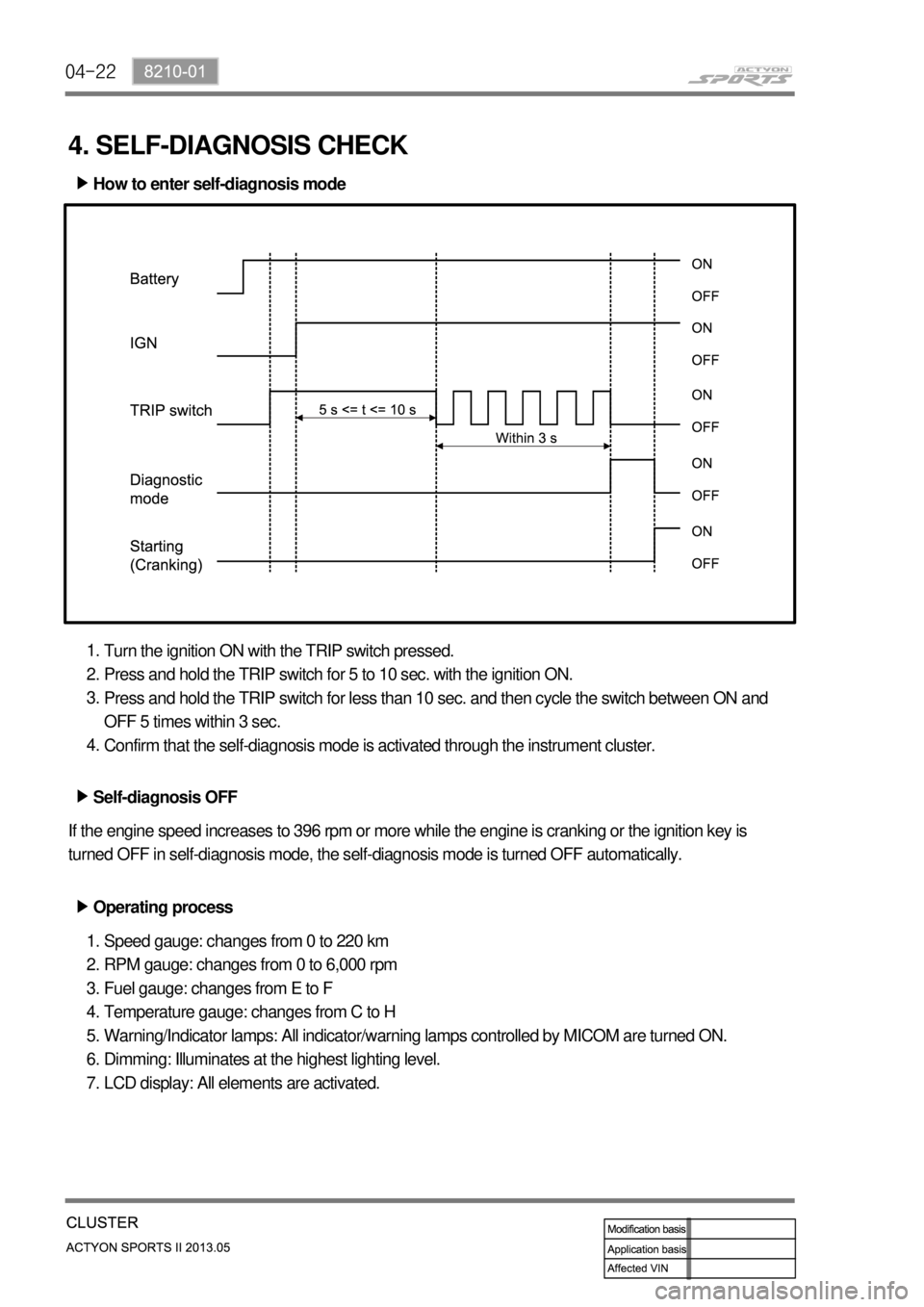
04-22
How to enter self-diagnosis mode ▶
Turn the ignition ON with the TRIP switch pressed.
Press and hold the TRIP switch for 5 to 10 sec. with the ignition ON.
Press and hold the TRIP switch for less than 10 sec. and then cycle the switch between ON and
OFF 5 times within 3 sec.
Confirm that the self-diagnosis mode is activated through the instrument cluster. 1.
2.
3.
4.
4. SELF-DIAGNOSIS CHECK
Self-diagnosis OFF ▶
If the engine speed increases to 396 rpm or more while the engine is cranking or the ignition key is
turned OFF in self-diagnosis mode, the self-diagnosis mode is turned OFF automatically.
Operating process ▶
Speed gauge: changes from 0 to 220 km
RPM gauge: changes from 0 to 6,000 rpm
Fuel gauge: changes from E to F
Temperature gauge: changes from C to H
Warning/Indicator lamps: All indicator/warning lamps controlled by MICOM are turned ON.
Dimming: Illuminates at the highest lighting level.
LCD display: All elements are activated. 1.
2.
3.
4.
5.
6.
7.
Page 415 of 751
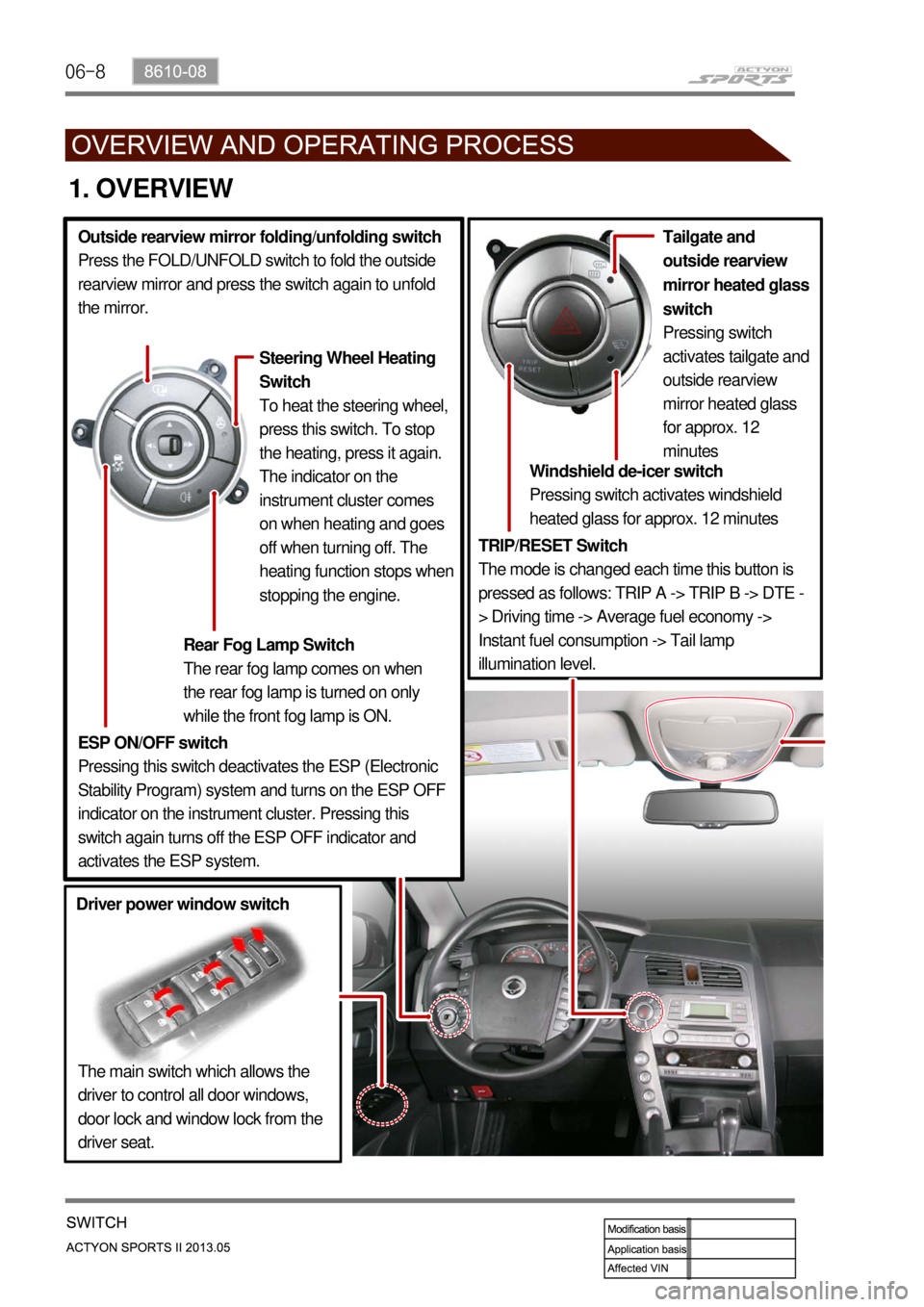
06-8
1. OVERVIEW
TRIP/RESET Switch
The mode is changed each time this button is
pressed as follows: TRIP A -> TRIP B -> DTE -
> Driving time -> Average fuel economy ->
Instant fuel consumption -> Tail lamp
illumination level.Windshield de-icer switch
Pressing switch activates windshield
heated glass for approx. 12 minutes
The main switch which allows the
driver to control all door windows,
door lock and window lock from the
driver seat. Tailgate and
outside rearview
mirror heated glass
switch
Pressing switch
activates tailgate and
outside rearview
mirror heated glass
for approx. 12
minutes
Driver power window switchESP ON/OFF switch
Pressing this switch deactivates the ESP (Electronic
Stability Program) system and turns on the ESP OFF
indicator on the instrument cluster. Pressing this
switch again turns off the ESP OFF indicator and
activates the ESP system. Outside rearview mirror folding/unfolding switch
Press the FOLD/UNFOLD switch to fold the outside
rearview mirror and press the switch again to unfold
the mirror.
Rear Fog Lamp Switch
The rear fog lamp comes on when
the rear fog lamp is turned on only
while the front fog lamp is ON.
Steering Wheel Heating
Switch
To heat the steering wheel,
press this switch. To stop
the heating, press it again.
The indicator on the
instrument cluster comes
on when heating and goes
off when turning off. The
heating function stops when
stopping the engine.
Page 449 of 751
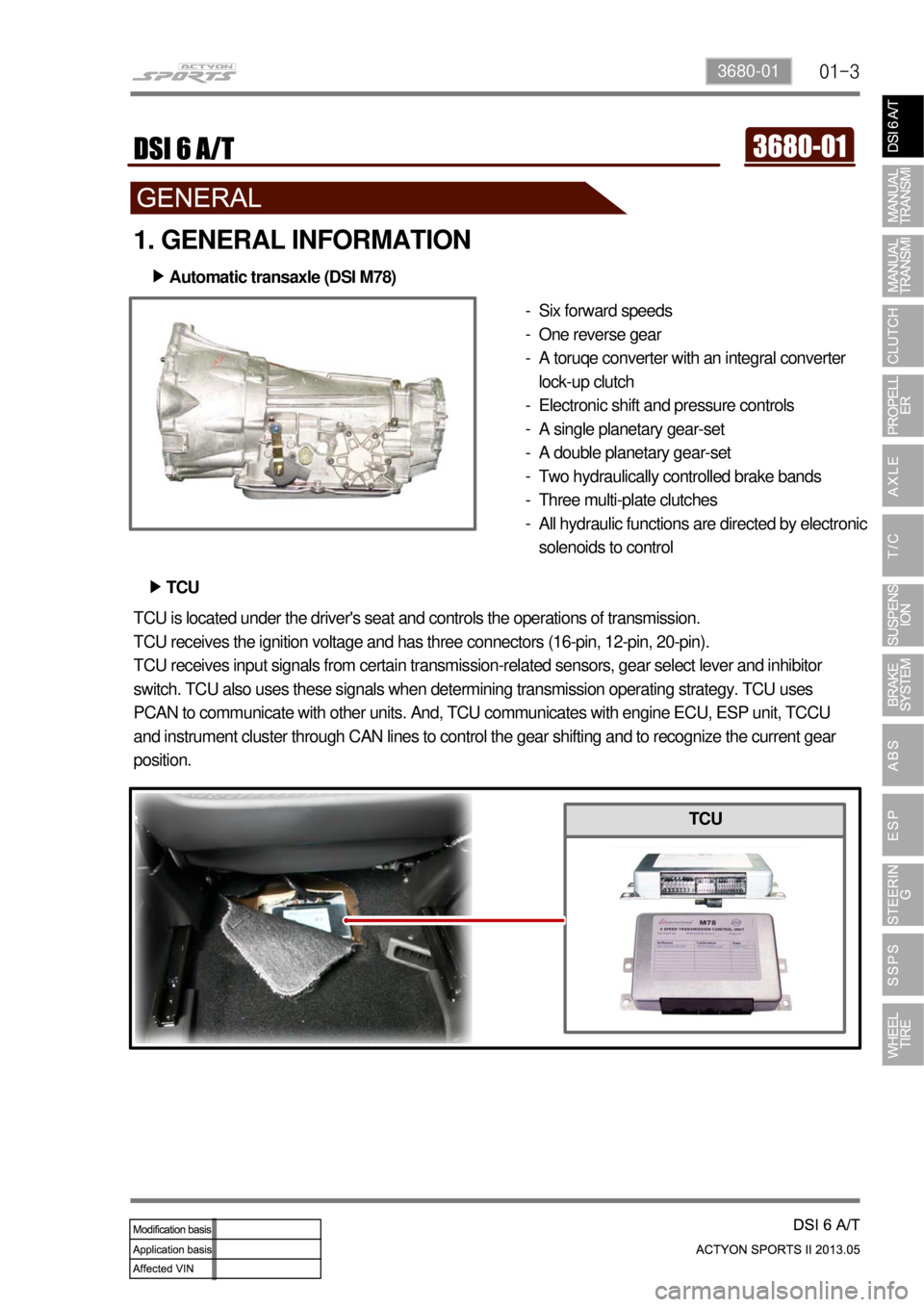
01-33680-01
1. GENERAL INFORMATION
Six forward speeds
One reverse gear
A toruqe converter with an integral converter
lock-up clutch
Electronic shift and pressure controls
A single planetary gear-set
A double planetary gear-set
Two hydraulically controlled brake bands
Three multi-plate clutches
All hydraulic functions are directed by electronic
solenoids to control -
-
-
-
-
-
-
-
- Automatic transaxle (DSI M78) ▶
TCU ▶
TCU is located under the driver's seat and controls the operations of transmission.
TCU receives the ignition voltage and has three connectors (16-pin, 12-pin, 20-pin).
TCU receives input signals from certain transmission-related sensors, gear select lever and inhibitor
switch. TCU also uses these signals when determining transmission operating strategy. TCU uses
PCAN to communicate with other units. And, TCU communicates with engine ECU, ESP unit, TCCU
and instrument cluster through CAN lines to control the gear shifting and to recognize the current gear
position.
TCU
Page 450 of 751
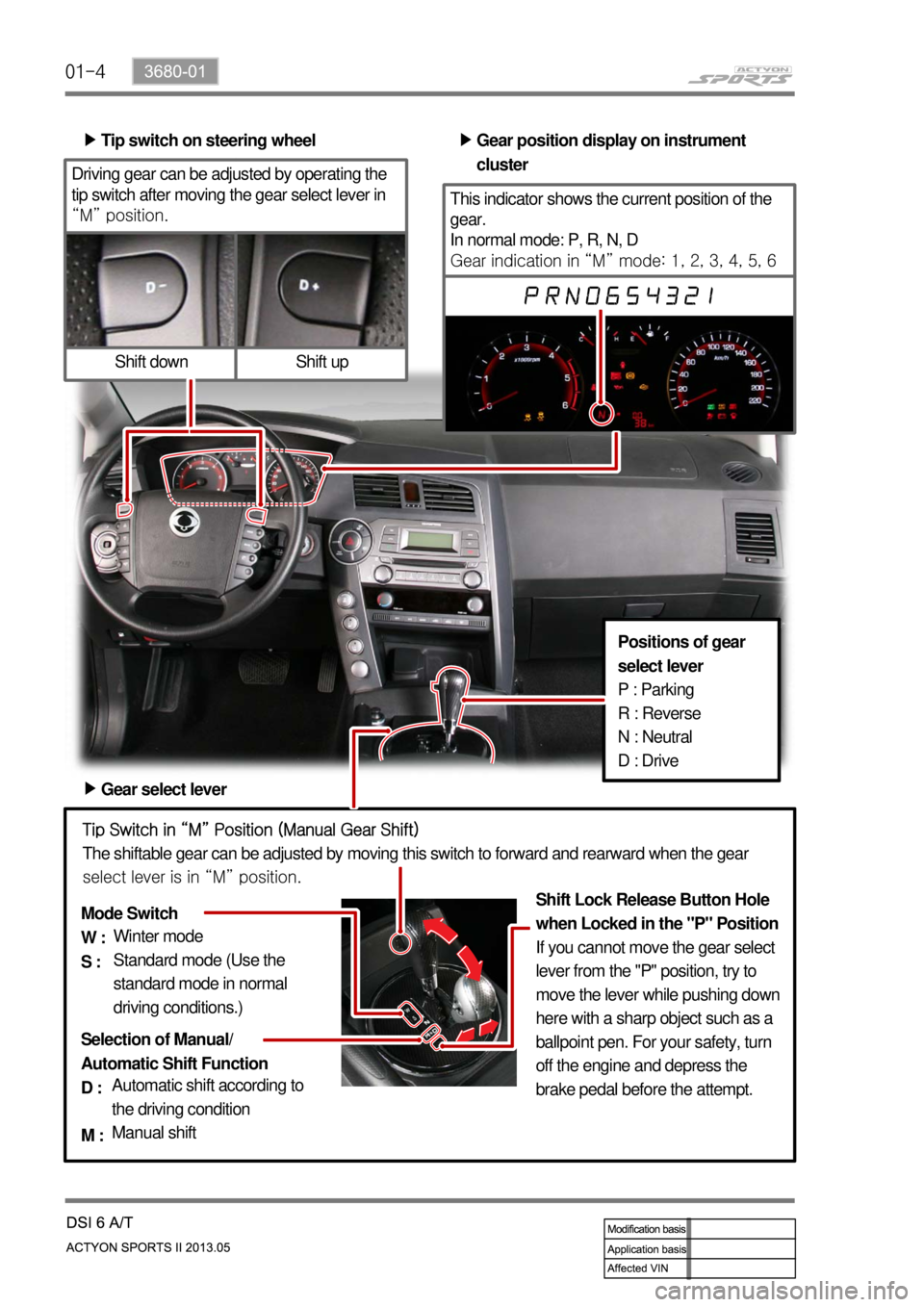
01-4
This indicator shows the current position of the
gear.
In normal mode: P, R, N, D
Gear indication in “M” mode: 1, 2, 3, 4, 5, 6
Driving gear can be adjusted by operating the
tip switch after moving the gear select lever in
“M” position.
Shift down Shift up
Tip switch on steering wheel ▶
Gear position display on instrument
cluster ▶
Gear select lever ▶
Mode Switch
W :
S :
Selection of Manual/
Automatic Shift Function
D :
M :Shift Lock Release Button Hole
when Locked in the "P" Position
If you cannot move the gear select
lever from the "P" position, try to
move the lever while pushing down
here with a sharp object such as a
ballpoint pen. For your safety, turn
off the engine and depress the
brake pedal before the attempt. Tip Switch in “M” Position (Manual Gear Shift)
The shiftable gear can be adjusted by moving this switch to forward and rearward when the gear
select lever is in “M” position.
Positions of gear
select lever
P : Parking
R : Reverse
N : Neutral
D : Drive
Winter mode
Standard mode (Use the
standard mode in normal
driving conditions.)
Automatic shift according to
the driving condition
Manual shift
Page 462 of 751
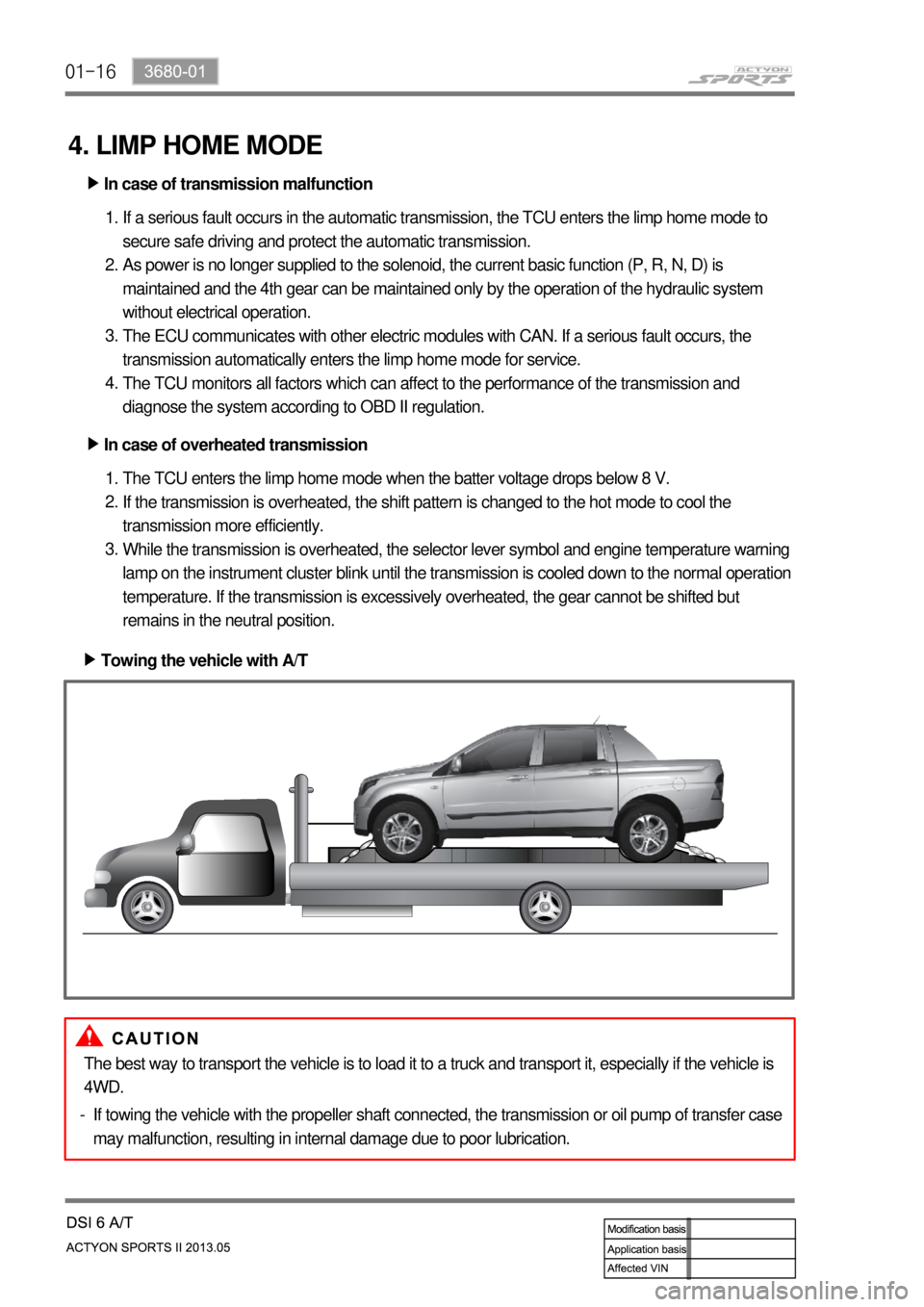
01-16
4. LIMP HOME MODE
In case of transmission malfunction ▶
If a serious fault occurs in the automatic transmission, the TCU enters the limp home mode to
secure safe driving and protect the automatic transmission.
As power is no longer supplied to the solenoid, the current basic function (P, R, N, D) is
maintained and the 4th gear can be maintained only by the operation of the hydraulic system
without electrical operation.
The ECU communicates with other electric modules with CAN. If a serious fault occurs, the
transmission automatically enters the limp home mode for service.
The TCU monitors all factors which can affect to the performance of the transmission and
diagnose the system according to OBD II regulation. 1.
2.
3.
4.
In case of overheated transmission ▶
The TCU enters the limp home mode when the batter voltage drops below 8 V.
If the transmission is overheated, the shift pattern is changed to the hot mode to cool the
transmission more efficiently.
While the transmission is overheated, the selector lever symbol and engine temperature warning
lamp on the instrument cluster blink until the transmission is cooled down to the normal operation
temperature. If the transmission is excessively overheated, the gear cannot be shifted but
remains in the neutral position. 1.
2.
3.
Towing the vehicle with A/T ▶
The best way to transport the vehicle is to load it to a truck and transport it, especially if the vehicle is
4WD.
If towing the vehicle with the propeller shaft connected, the transmission or oil pump of transfer case
may malfunction, resulting in internal damage due to poor lubrication. -
Page 463 of 751
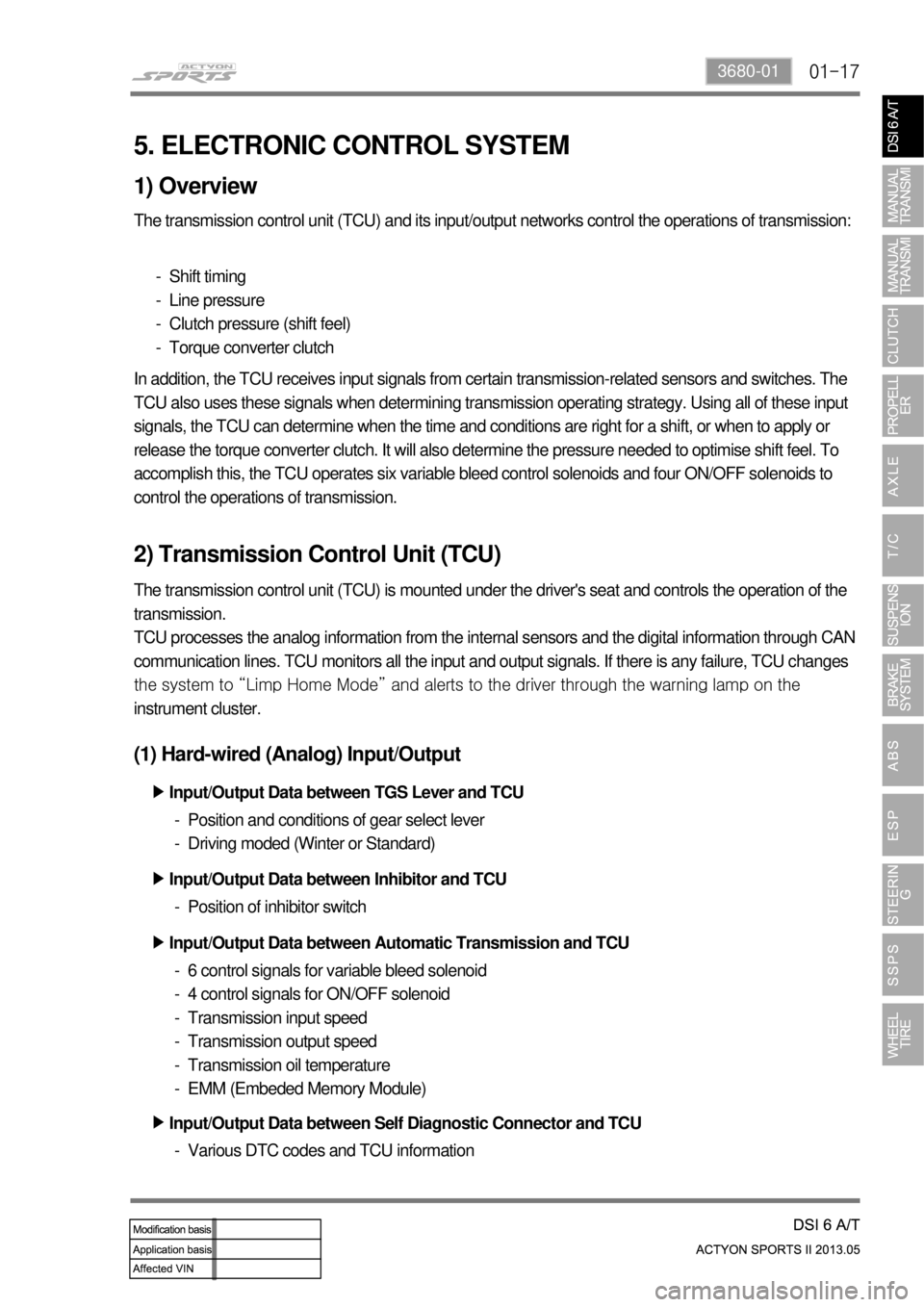
01-173680-01
5. ELECTRONIC CONTROL SYSTEM
1) Overview
The transmission control unit (TCU) and its input/output networks control the operations of transmission:
Shift timing
Line pressure
Clutch pressure (shift feel)
Torque converter clutch -
-
-
-
In addition, the TCU receives input signals from certain transmission-related sensors and switches. The
TCU also uses these signals when determining transmission operating strategy. Using all of these input
signals, the TCU can determine when the time and conditions are right for a shift, or when to apply or
release the torque converter clutch. It will also determine the pressure needed to optimise shift feel. To
accomplish this, the TCU operates six variable bleed control solenoids and four ON/OFF solenoids to
control the operations of transmission.
2) Transmission Control Unit (TCU)
The transmission control unit (TCU) is mounted under the driver's seat and controls the operation of the
transmission.
TCU processes the analog information from the internal sensors and the digital information through CAN
communication lines. TCU monitors all the input and output signals. If there is any failure, TCU changes
the system to “Limp Home Mode” and alerts to the driver through the warning lamp on the
instrument cluster.
(1) Hard-wired (Analog) Input/Output
Input/Output Data between TGS Lever and TCU ▶
Position and conditions of gear select lever
Driving moded (Winter or Standard) -
-
Position of inhibitor switch - Input/Output Data between Inhibitor and TCU ▶
6 control signals for variable bleed solenoid
4 control signals for ON/OFF solenoid
Transmission input speed
Transmission output speed
Transmission oil temperature
EMM (Embeded Memory Module) -
-
-
-
-
- Input/Output Data between Automatic Transmission and TCU ▶
Input/Output Data between Self Diagnostic Connector and TCU ▶
Various DTC codes and TCU information -
Page 611 of 751
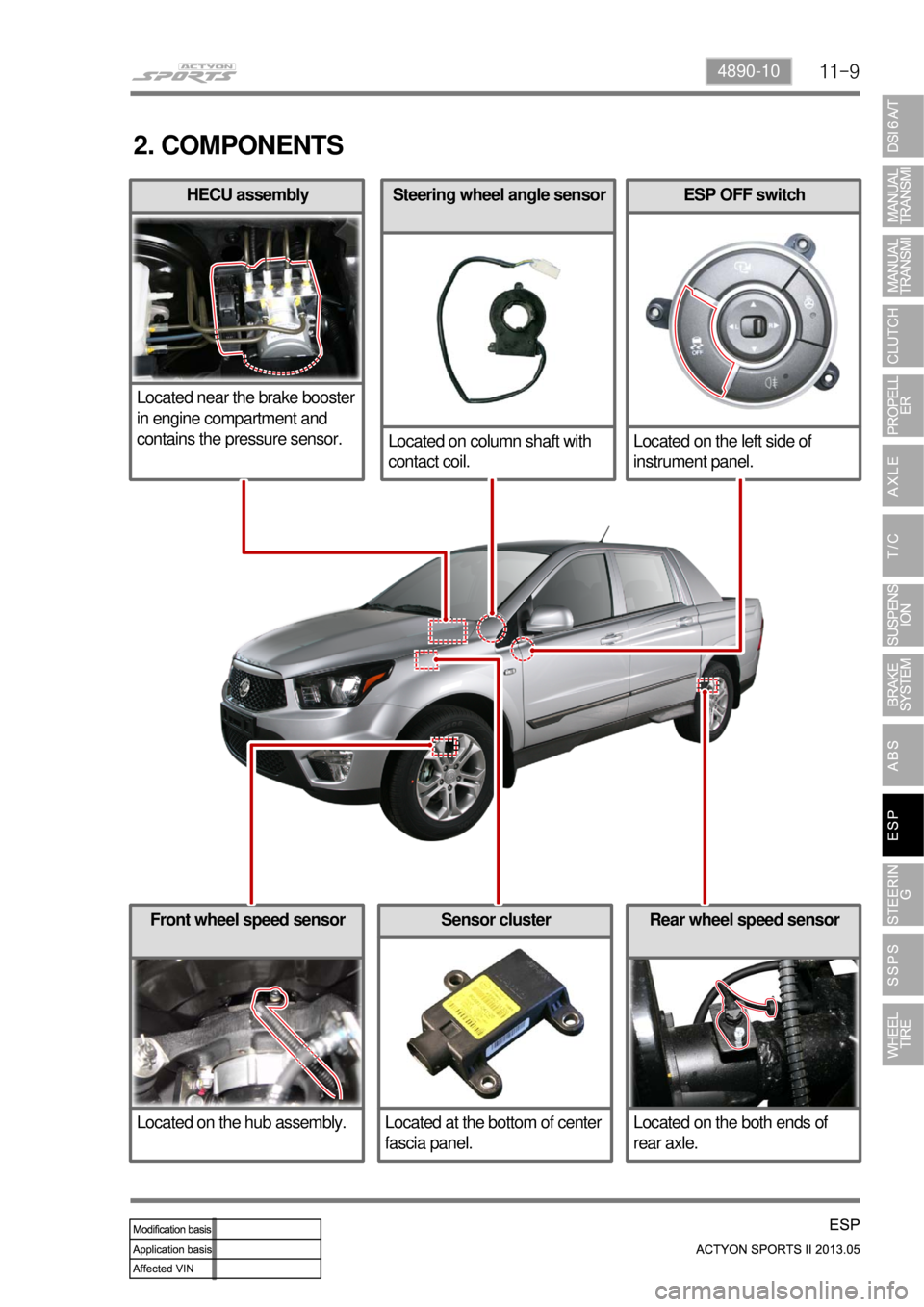
11-94890-10
ESP OFF switch
Located on the left side of
instrument panel.
Rear wheel speed sensor
Located on the both ends of
rear axle.Front wheel speed sensor
Located on the hub assembly.Sensor cluster
Located at the bottom of center
fascia panel.
Steering wheel angle sensor
Located on column shaft with
contact coil.HECU assembly
Located near the brake booster
in engine compartment and
contains the pressure sensor.
2. COMPONENTS
Page 616 of 751
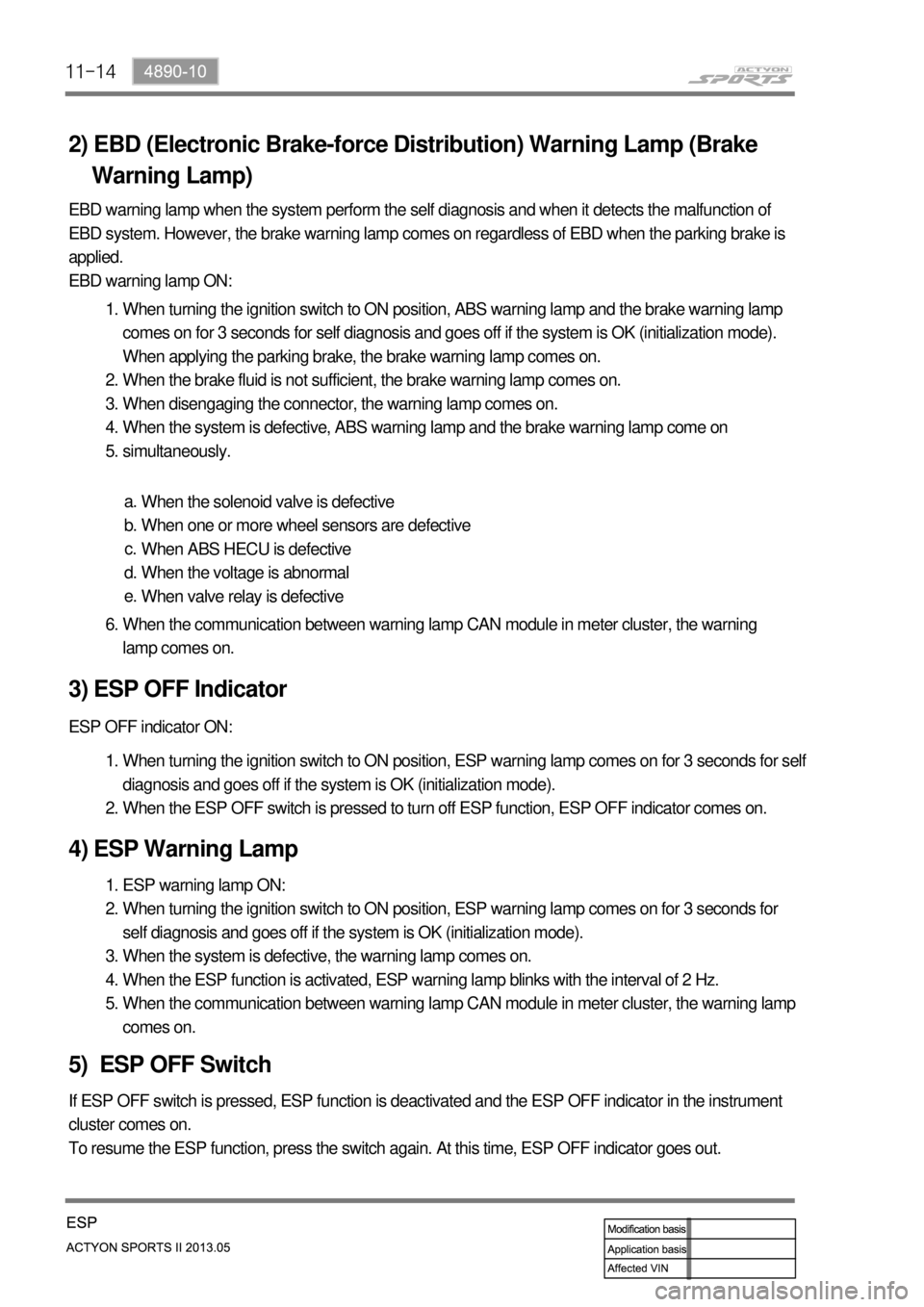
11-14
2) EBD (Electronic Brake-force Distribution) Warning Lamp (Brake
Warning Lamp)
EBD warning lamp when the system perform the self diagnosis and when it detects the malfunction of
EBD system. However, the brake warning lamp comes on regardless of EBD when the parking brake is
applied.
EBD warning lamp ON:
When turning the ignition switch to ON position, ABS warning lamp and the brake warning lamp
comes on for 3 seconds for self diagnosis and goes off if the system is OK (initialization mode).
When applying the parking brake, the brake warning lamp comes on.
When the brake fluid is not sufficient, the brake warning lamp comes on.
When disengaging the connector, the warning lamp comes on.
When the system is defective, ABS warning lamp and the brake warning lamp come on
simultaneously. 1.
2.
3.
4.
5.
When the solenoid valve is defective
When one or more wheel sensors are defective
When ABS HECU is defective
When the voltage is abnormal
When valve relay is defective a.
b.
c.
d.
e.
When the communication between warning lamp CAN module in meter cluster, the warning
lamp comes on. 6.
3) ESP OFF Indicator
ESP OFF indicator ON:
When turning the ignition switch to ON position, ESP warning lamp comes on for 3 seconds for self
diagnosis and goes off if the system is OK (initialization mode).
When the ESP OFF switch is pressed to turn off ESP function, ESP OFF indicator comes on. 1.
2.
4) ESP Warning Lamp
ESP warning lamp ON:
When turning the ignition switch to ON position, ESP warning lamp comes on for 3 seconds for
self diagnosis and goes off if the system is OK (initialization mode).
When the system is defective, the warning lamp comes on.
When the ESP function is activated, ESP warning lamp blinks with the interval of 2 Hz.
When the communication between warning lamp CAN module in meter cluster, the warning lamp
comes on. 1.
2.
3.
4.
5.
5) ESP OFF Switch
If ESP OFF switch is pressed, ESP function is deactivated and the ESP OFF indicator in the instrument
cluster comes on.
To resume the ESP function, press the switch again. At this time, ESP OFF indicator goes out.